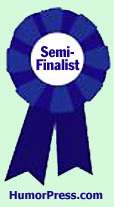“This is your captain speaking,” said Captain Tad Armstrong. “We have reached a cruising altitude of 80,000 feet—”
“30,000,” said Sunny Davis, the co-pilot.
“You sure?”
“Yeah.”
“Dang,” Tad said. “The 3 always looks like an 8 to me…—an altitude of 30,000 feet. So just sit back, relax, and enjoy your flight.”
Tad unzipped his flight bag and fished out a travel size box of Lucky Charms, and a plastic bowl and spoon. Sunny opened a newspaper and propped it up, blocking his view of Tad.
“Which do you think is the luckiest Lucky Charm?” Tad asked.
“Hmm?” Sunny said.
“I used to think it was green clovers,” Tad said. “The Lucky Charms clovers have four leaves and that’s lucky right? Except one time I was in a park and I looked down and there were a whole bunch of four-leaf clovers on the ground. If there are that many of them, how lucky can they really be? Everybody who wandered into their backyard would get lucky and that’s clearly not happening. Plus, I’m not Irish. I’m American and so is just about everybody else, so I don’t think it applies to most people.”
“Uh-huh,” Sunny said.
“Pink hearts?” Tad said. “Hearts are red. Everyone’s got one, so it’s not like they are rare. And when you hear ‘heart,’ what goes along with it? ‘Broken-hearted.’ Sounds like bum luck to me.
“OK.”
“Purple horseshoes? Maybe if the horse was a girl-horse it would be OK, but then wouldn’t you want shoes with heals on them? But they’re flat, see?” Tad reached around the newspaper to hold the horseshoe in front of Sunny then put it in his mouth, chewed twice—without effect—and swallowed it.
He continued: “Take orange stars and yellow moons together, because they’re both astronomical. Moons have to be some color and yellow is about right. See?” Tad lobbed a moon above the top of Sunny’s newspaper, caught it in his mouth and swallowed it—this time without chewing.
“Here is the problem,” Tad explained. “Moons are lucky, but not all the time. Just about all the time the moons are yellow. And when are they lucky? When they are half-yellow? No. Three-quarters-yellow? Full moon? Little yellow sliver of a moon? No, no, no. Moons are lucky when they’re ‘new’ moons. In other words, they’re lucky when they’re not yellow. So why are they in the box if they’re not lucky? I wrote General Mills about it when I was a kid—pointed out the yellow problem. Month later, I got a letter that said ‘thanks for writing,’ but nothing about the issue at hand. They enclosed a coupon for a family-size box though. So that leaves the orange stars.”
“So?”
“You wish upon a star. Sometimes the wishes come true, sometimes they don’t. Which raises the point: Does a lucky charm need to be lucky all the time? Does it depend on which star you pick so there are some lucky stars and some unlucky stars?”
“Don’t know.”
“Exactly my point, Sunny,” Tad said. “When you wish upon a star and get what you want, is that lucky or is it divine intervention? If it’s a higher power picking sides, it’s not exactly luck, is it? Plus, people who live on farms have an unfair advantage. If you live on a farm and it’s a clear night, you can see a million stars. You can probably see all of them if you have a telescope. So even if you wish on a string of dud stars, sooner or later, you are going to get a lucky one. If you live in the city, you might see one or two a night. Maybe the answer there is to sell two different versions of the cereal. People who live in the country get the orange stars; people who live in the city don’t. But anyway, the orange stars are lucky for some people some of the time and that’s better than nothing.”
“Sure.”
“Last one: Blue Diamond. Have you ever seen a real blue diamond?”
“Uh-uh.”
“Me neither, but if I had one I’d be lucky already because I’d sell it for a bundle. With all the other ones, you get them and then maybe something lucky happens to you. With the Blue Diamond, just having it is lucky. And that’s why I like it. That’s why I keep a Blue Diamond Marshmallow in the fold of my flight cap. Always have.”
